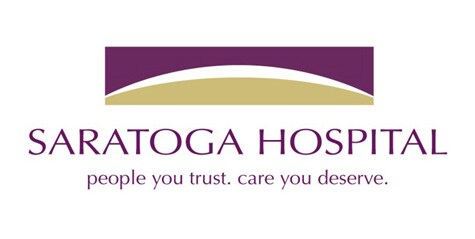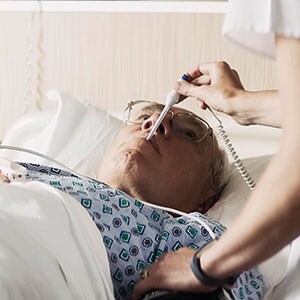Early warnings. Empowered nurses.
Reducing codes on the ward
In 2013, Saratoga Hospital in New York underwent a redesign of its ICU, a move that prompted its intensive care services team to explore the broader issue of patient deterioration across the hospital, to possibly reduce the number of transfers to the ICU. While patients are closely and often continuously monitored in an ICU, on a general care unit the process and protocols can be much more manual and periodic. At Saratoga, as most hospitals, patient safety is an equal priority in both care settings.

Talk to us about breaking boundaries
Health knows no bounds. And neither should healthcare.
Talk to us about breaking boundaries
Addressing adverse events at Saratoga Hospital
Since the 1980s, Saratoga Hospital has transformed into a thriving institution that anchors a growing network of healthcare services, including primary care, urgent care, imaging, occupational health, ambulatory surgery, rehabilitation, oncology, and a new community health center. Its physician and nursing staff has grown and they are delivering much broader healthcare services to its community, enabled by technology. The most recent endeavor to meet the community healthcare needs was a multimillion-dollar project consisting of a new 19-bed intensive care unit and a complete surgical service renovation with the addition of 10 operating rooms. As part of the ICU overhaul, Diane Bartos, Administrative Director of the Intensive Care Unit, Cardiovascular Services, at Saratoga Hospital, conducted research on patient events across their units, the result of which identified a need for more support of nursing staff as they dealt with patient events including those outside of the ICU. Research showed that there was an opportunity to apply technology in the general ward that could help in reducing a patient’s likelihood of returning to the ICU. There are 440,000 preventable adverse events that contribute to patient deaths in U.S. hospitals every year.1
The patient was starting to deteriorate, but sometimes there were indications from the patient that were happening that the nurses weren't necessarily picking up.”
Diane Bartos
Administrative Director, Intensive Care Unit, Cardiovascular Services, Saratoga Hospital
Installing an automated early warning scoring system
An adverse event would commonly lead to a ‘code’, when a patient stops breathing or their heart stops beating. The objective of every hospital is to reduce patient codes by intervening at the point of patient deterioration. Research has shown that 66%2 of cardiac arrest patients show signs and symptoms up to 6 hours prior to an event but physicians are only notified 25% of the time. Saratoga Hospital’s objective was to empower nurses through technology to be able to make critical interventions—and provide them with the confidence to be able to receive information and act on it much more quickly. Prior to automating early warning scoring, it was difficult to identify when patients were deteriorating. “We did identify that we had an issue, even prior to calling a rapid response, with the patient starting to deteriorate but sometimes there were indications from the patient that were happening that the nurses weren't necessarily picking up,” says Dr. Bartos.
Reducing patient events
The solution was installation of Philips IntelliVue Guardian Solution, an automated early warning scoring (EWS) system that can aid clinicians in identifying subtle signs of deterioration in a patient’s condition, hours before a potential adverse event occurs. Saratoga Hospital installed Philips IntelliVue Guardian Solution in two phases between 2013 and 2015 on two units. Philips IntelliVue MP5SC patient monitors were installed at every bedside unit, which capture vital signs that are tracked by Guardian software at the bedside and at the central station. The system helps the clinician detect subtle signs of deterioration, automates EWS calculations and alerts care providers. “It looks at key vital signs, and it gives a point score for each vital sign that's abnormal with a total point score. If they need help, the ICU can help them in responding to that score and/or the charge nurse will follow up with the physicians,” says Dr. Bartos. “It's intuitive, it tells nurses what is going on and helps them to make a confident decision.” Installing early warning scoring technology led to a reduction in patient codes and the orthopaedic unit having no codes in the four years since installation. “We're trying to provide care as safely as possible, and we don't want that patient to deteriorate at all,” says Bartos. “As we're providing care, doing interventions, we're trying to provide care in the safest environment possible. We have shown over time and very dramatically right after implementing early warning scoring, that we have decreased the number of codes dramatically.”
Saratoga Hospital
Regional provider to a growing population of 240,000 people in New York State, with 171 beds, more than 400 doctors, 21 locations and 52 specialties
County had consistent population growth for the past four decades, with the City of Saratoga Springs showing the largest percentage of growth (31.5%); is still the fastest growing city in the state3
As part of an IDN, the hospital is preparing itself for increased patient demands, driven by rising chronic diseases and ageing populations
We're trying to provide care as safely as possible, and we don't want that patient to deteriorate at all."
Diane Bartos Administrative Director, Intensive Care Unit, Cardiovascular Services, Saratoga Hospital

No bounds.
Better healthcare.
There's always a way to make life better.
DISCLAIMER: FOOTNOTES: [1] James, JT. A New, Evidence-based Estimate of Patient Harms Associated with Hospital Care. Journal of Patient Safety: September 2013 - Volume 9 - Issue 3 - p 122–128. [2] Franklin C, Mathew J. Developing strategies to prevent in hospital cardiac arrest: analyzing responses of physicians and nurses in the hours before the event. Crit Care Med. 1994;22(2):244-247 [3] Albany Business Review, 2017 – ‘New Census estimates show upstate falling further behind in population’
Results from case studies are not predictive of results in other cases. Results in other cases may vary.

